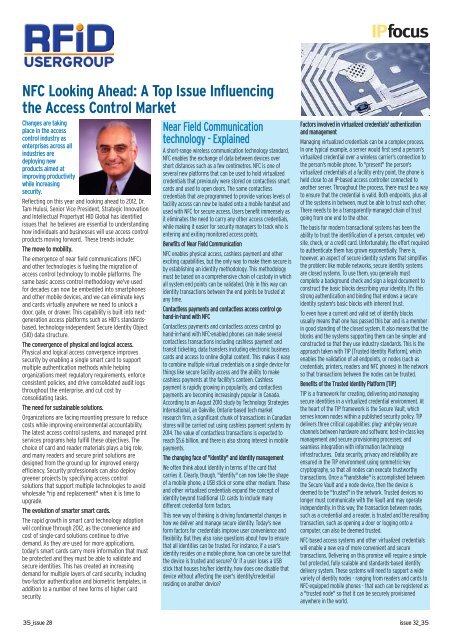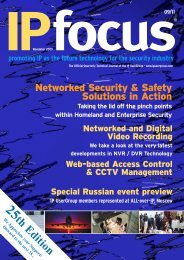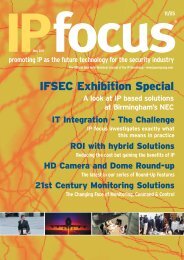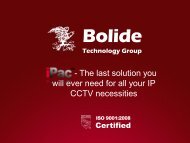IPfocus - IP UserGroup
IPfocus - IP UserGroup
IPfocus - IP UserGroup
Create successful ePaper yourself
Turn your PDF publications into a flip-book with our unique Google optimized e-Paper software.
<strong><strong>IP</strong>focus</strong><br />
NFC Looking Ahead: A Top Issue Influencing<br />
the Access Control Market<br />
Changes are taking<br />
place in the access<br />
control industry as<br />
enterprises across all<br />
industries are<br />
deploying new<br />
products aimed at<br />
improving productivity<br />
while increasing<br />
security.<br />
Reflecting on this year and looking ahead to 2012, Dr.<br />
Tam Hulusi, Senior Vice President, Strategic Innovation<br />
and Intellectual Propertyat HID Global has identified<br />
issues that he believes are essential to understanding<br />
how individuals and businesses will use access control<br />
products moving forward. These trends include:<br />
The move to mobility.<br />
The emergence of near field communications (NFC)<br />
and other technologies is fueling the migration of<br />
access control technology to mobile platforms. The<br />
same basic access control methodology we've used<br />
for decades can now be embedded into smartphones<br />
and other mobile devices, and we can eliminate keys<br />
and cards virtually anywhere we need to unlock a<br />
door, gate, or drawer. This capability is built into nextgeneration<br />
access platforms such as HID’s standardsbased,<br />
technology-independent Secure Identity Object<br />
(SIO) data structure.<br />
The convergence of physical and logical access.<br />
Physical and logical access convergence improves<br />
security by enabling a single smart card to support<br />
multiple authentication methods while helping<br />
organizations meet regulatory requirements, enforce<br />
consistent policies, and drive consolidated audit logs<br />
throughout the enterprise, and cut cost by<br />
consolidating tasks.<br />
The need for sustainable solutions.<br />
Organizations are facing mounting pressure to reduce<br />
costs while improving environmental accountability.<br />
The latest access control systems, and managed print<br />
services programs help fulfill these objectives. The<br />
choice of card and reader materials plays a big role,<br />
and many readers and secure print solutions are<br />
designed from the ground up for improved energy<br />
efficiency. Security professionals can also deploy<br />
greener projects by specifying access control<br />
solutions that support multiple technologies to avoid<br />
wholesale "rip and replacement" when it is time to<br />
upgrade.<br />
The evolution of smarter smart cards.<br />
The rapid growth in smart card technology adoption<br />
will continue through 2012, as the convenience and<br />
cost of single-card solutions continue to drive<br />
demand. As they are used for more applications,<br />
today's smart cards carry more information that must<br />
be protected and they must be able to validate and<br />
secure identities. This has created an increasing<br />
demand for multiple layers of card security, including<br />
two-factor authentication and biometric templates, in<br />
addition to a number of new forms of higher card<br />
security.<br />
Near Field Communication<br />
technology - Explained<br />
A short-range wireless communication technology standard,<br />
NFC enables the exchange of data between devices over<br />
short distances such as a few centimetres. NFC is one of<br />
several new platforms that can be used to hold virtualized<br />
credentials that previously were stored on contactless smart<br />
cards and used to open doors. The same contactless<br />
credentials that are programmed to provide various levels of<br />
facility access can now be loaded onto a mobile handset and<br />
used with NFC for secure access. Users benefit immensely as<br />
it eliminates the need to carry any other access credentials,<br />
while making it easier for security managers to track who is<br />
entering and exiting monitored access points.<br />
Benefits of Near Field Communication<br />
NFC enables physical access, cashless payment and other<br />
exciting capabilities, but the only way to make them secure is<br />
by establishing an identity methodology. This methodology<br />
must be based on a comprehensive chain of custody in which<br />
all system end points can be validated. Only in this way can<br />
identity transactions between the end points be trusted at<br />
any time.<br />
Contactless payments and contactless access control go<br />
hand-in-hand with NFC<br />
Contactless payments and contactless access control go<br />
hand-in-hand with NFC-enabled phones can make several<br />
contactless transactions including cashless payment and<br />
transit ticketing, data transfers including electronic business<br />
cards and access to online digital content. This makes it easy<br />
to combine multiple virtual credentials on a single device for<br />
things like secure facility access and the ability to make<br />
cashless payments at the facility's canteen. Cashless<br />
payment is rapidly growing in popularity, and contactless<br />
payments are becoming increasingly popular in Canada.<br />
According to an August 2010 study by Technology Strategies<br />
International, an Oakville, Ontario-based tech market<br />
research firm, a significant chunk of transactions in Canadian<br />
stores will be carried out using cashless payment systems by<br />
2014. The value of contactless transactions is expected to<br />
reach $5.6 billion, and there is also strong interest in mobile<br />
payments.<br />
The changing face of "identity" and identity management<br />
We often think about identity in terms of the card that<br />
carries it. Clearly, though, "identity" can now take the shape<br />
of a mobile phone, a USB stick or some other medium. These<br />
and other virtualized credentials expand the concept of<br />
identity beyond traditional I.D. cards to include many<br />
different credential form factors.<br />
This new way of thinking is driving fundamental changes in<br />
how we deliver and manage secure identity. Today's new<br />
form factors for credentials improve user convenience and<br />
flexibility. But they also raise questions about how to ensure<br />
that all identities can be trusted. For instance, if a user's<br />
identity resides on a mobile phone, how can one be sure that<br />
the device is trusted and secure? Or if a user loses a USB<br />
stick that houses his/her identity, how does one disable that<br />
device without affecting the user's identity/credential<br />
residing on another device?<br />
Factors involved in virtualized credentials' authentication<br />
and management<br />
Managing virtualized credentials can be a complex process.<br />
In one typical example, a server would first send a person's<br />
virtualized credential over a wireless carrier's connection to<br />
the person's mobile phone. To "present" the person's<br />
virtualized credentials at a facility entry point, the phone is<br />
held close to an <strong>IP</strong>-based access controller connected to<br />
another server. Throughout the process, there must be a way<br />
to ensure that the credential is valid. Both endpoints, plus all<br />
of the systems in between, must be able to trust each other.<br />
There needs to be a transparently-managed chain of trust<br />
going from one end to the other.<br />
The basis for modern transactional systems has been the<br />
ability to trust the identification of a person, computer, web<br />
site, check, or a credit card. Unfortunately, the effort required<br />
to authenticate them has grown exponentially. There is,<br />
however, an aspect of secure identity systems that simplifies<br />
the problem: like mobile networks, secure identity systems<br />
are closed systems. To use them, you generally must<br />
complete a background check and sign a legal document to<br />
construct the basic blocks describing your identity. It's this<br />
strong authentication and binding that endows a secure<br />
identity system's basic blocks with inherent trust.<br />
To even have a current and valid set of identity blocks<br />
usually means that one has passed this bar and is a member<br />
in good standing of the closed system. It also means that the<br />
blocks and the systems supporting them can be simpler and<br />
constructed so that they use industry standards. This is the<br />
approach taken with T<strong>IP</strong> [Trusted Identity Platform], which<br />
enables the validation of all endpoints, or nodes (such as<br />
credentials, printers, readers and NFC phones) in the network<br />
so that transactions between the nodes can be trusted.<br />
Benefits of the Trusted Identity Platform [T<strong>IP</strong>]<br />
T<strong>IP</strong> is a framework for creating, delivering and managing<br />
secure identities in a virtualized credential environment. At<br />
the heart of the T<strong>IP</strong> framework is the Secure Vault, which<br />
serves known nodes within a published security policy. T<strong>IP</strong><br />
delivers three critical capabilities: plug- and-play secure<br />
channels between hardware and software; best-in-class key<br />
management and secure provisioning processes; and<br />
seamless integration with information technology<br />
infrastructures. Data security, privacy and reliability are<br />
ensured in the T<strong>IP</strong> environment using symmetric-key<br />
cryptography, so that all nodes can execute trustworthy<br />
transactions. Once a "handshake" is accomplished between<br />
the Secure Vault and a node device, then the device is<br />
deemed to be "trusted" in the network. Trusted devices no<br />
longer must communicate with the Vault and may operate<br />
independently. In this way, the transaction between nodes,<br />
such as a credential and a reader, is trusted and the resulting<br />
transaction, such as opening a door or logging onto a<br />
computer, can also be deemed trusted.<br />
NFC-based access systems and other virtualized credentials<br />
will enable a new era of more convenient and secure<br />
transactions. Delivering on this promise will require a simple<br />
but protected, fully scalable and standards-based identity<br />
delivery system. These systems will need to support a wide<br />
variety of identity nodes - ranging from readers and cards to<br />
NFC-equipped mobile phones - that each can be registered as<br />
a "trusted node" so that it can be securely provisioned<br />
anywhere in the world.<br />
35_issue 28<br />
issue 32_35














